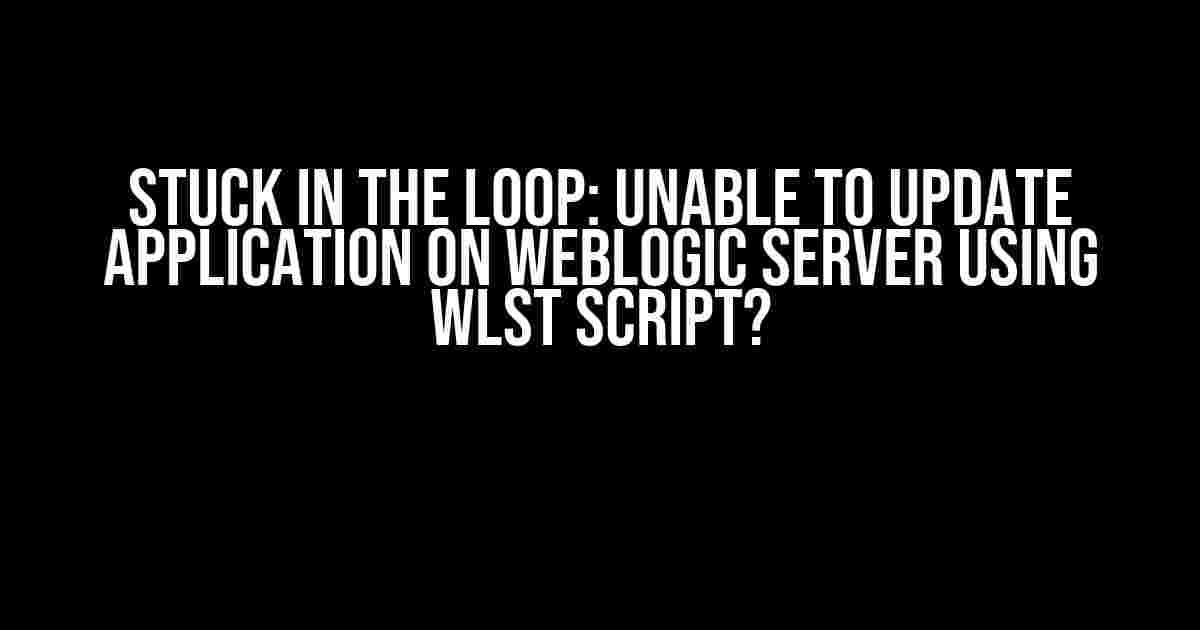Are you tired of banging your head against the wall, trying to update your application on WebLogic Server using WLST script, only to be met with error messages and frustration? Well, put down that aspirin and take a deep breath, because we’re about to dive into the world of WLST scripting and tackle this pesky issue once and for all!
What’s the Problem?
Before we dive into the solution, let’s take a step back and understand the problem at hand. You’ve got an application deployed on WebLogic Server, and you’re trying to update it using a WLST (WebLogic Scripting Tool) script. Sounds simple, right? But, for some reason, the update process just won’t budge. You’ve tried tweaking the script, adjusting the deployment options, and even performing a few rain dances (just kidding, or am I?), but nothing seems to work.
Common Errors and Issues
Here are some common errors and issues you might encounter when trying to update an application on WebLogic Server using WLST script:
- WLST script fails to connect to the WebLogic Server instance
- The application update process gets stuck in a loop, repeatedly deploying and undeploying the application
- The WLST script throws a “javax.naming.NamingException” error
- The application update is successful, but the changes are not reflected in the WebLogic Server console
Troubleshooting Steps
Now that we’ve identified the problem, let’s break down the troubleshooting process into manageable chunks. Follow these steps to identify and resolve the issue:
- Verify WLST Script Connection
- Check Application Deployment Status
- Review WLST Script Log Files
- Disable Auto-Deployment
- Update Application Using WLST Script
Make sure your WLST script is correctly configured to connect to the WebLogic Server instance. Double-check the server URL, username, and password in your script.
wls:/offline> connect('username','password','t3://localhost:7001')Verify the deployment status of your application using the WLST script. This will help you identify if the issue is specific to the update process or a broader deployment problem.
wls:/offline> deploymentManager.query('moduleName', 'moduleType')Inspect the WLST script log files to identify any error messages or exceptions that might be thrown during the update process.
wls:/offline> showLogs()Try disabling auto-deployment for the affected application. This might resolve any issues related to the application being stuck in a deployment loop.
wls:/offline> set('AutoDeploymentEnabled', 'false')Once you’ve addressed any underlying issues, try updating the application using the WLST script again. Make sure to specify the correct deployment plan and options.
wls:/offline> updateApplication('moduleName', 'moduleType', 'deploymentPlan')WLST Script Example
Here’s a complete WLST script example to update an application on WebLogic Server:
# Connect to the WebLogic Server instance
connect('username','password','t3://localhost:7001')
# Define the application name and module type
appName = 'myApp'
moduleType = 'ear'
# Define the deployment plan
deploymentPlan = 'myApp-plan.xml'
# Update the application
updateApplication(appName, moduleType, deploymentPlan)
# Disconnect from the WebLogic Server instance
disconnect()
WebLogic Server Configuration
Sometimes, the issue might be related to the WebLogic Server configuration rather than the WLST script itself. Here are some configuration checks to perform:
| Configuration Option | Description | Recommended Setting |
|---|---|---|
| AutoDeploymentEnabled | Enables or disables auto-deployment for applications | false |
| DeploymentTimeout | Sets the timeout value for deployment operations | 300 (5 minutes) |
| StagingMode | Specifies the staging mode for deployments | stage |
Make sure to review and adjust these configuration options to ensure they align with your application’s deployment requirements.
Conclusion
Unable to update your application on WebLogic Server using WLST script? Don’t worry, we’ve got you covered! By following the troubleshooting steps, reviewing the WLST script log files, and adjusting WebLogic Server configuration options, you should be able to resolve the issue and successfully update your application. Remember to stay calm, be patient, and don’t hesitate to seek help if you’re stuck.
Happy scripting!
Word count: 1067
Frequently Asked Question
Stuck with updating your application on WebLogic Server using WLST script? Don’t worry, we’ve got you covered! Here are some frequently asked questions and answers to help you troubleshoot the issue:
Q1: What are the common reasons for unable to update application on WebLogic Server using WLST script?
The most common reasons include incorrect WLST script syntax, incorrect application name or version, insufficient permissions, and network connectivity issues. Make sure to double-check your script and environment settings before trying to update the application.
Q2: How do I check if the WLST script is running with the correct permissions?
You can check the WLST script permissions by running the script with the `-verbose` option, which will display detailed information about the execution. Additionally, ensure that the user running the script has the necessary permissions and roles assigned in the WebLogic Server console.
Q3: What if I encounter a “Connection refused” error while running the WLST script?
This error usually occurs when the WLST script cannot connect to the WebLogic Server instance. Verify that the server is running, and the WLST script is using the correct server URL, username, and password. Also, check the server logs for any errors or issues that might be preventing the connection.
Q4: How can I troubleshoot issues with the WLST script syntax?
You can use the WLST built-in `dumpStack()` function to print the script’s stack trace, which will help you identify the exact line of code causing the issue. Additionally, you can use the ` Ant` script debugger or an IDE like Eclipse to debug the WLST script.
Q5: Are there any best practices to follow while updating applications on WebLogic Server using WLST script?
Yes, always follow best practices like testing the WLST script in a development environment before running it in production, using version control for your scripts, and keeping a record of changes made to the application. Additionally, ensure that the script is idempotent, meaning it can be run multiple times without causing issues.
